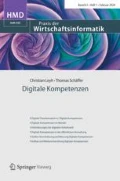Zusammenfassung
Additive Fertigung, umgangssprachlich als 3D-Druck bekannt, wird derzeit als Schlüsseltechnologie einer neuen industriellen Revolution gefördert. Die Technologie ermöglicht es, kundenspezifische Produkte zu produzieren, ohne dadurch erhöhte Kosten in der Herstellung zu verursachen, da weder Werkzeuge noch Formen erforderlich sind. Dies geschieht durch direkte digitale Fertigungsprozesse, die 3D-Daten direkt in physikalische Objekte umwandeln. Darüber hinaus kann das Schichtherstellungsprinzip auch funktional integrierte Teile in einem einzigen Fertigungsschritt produzieren und damit die Notwendigkeit von Montageaktivitäten reduzieren. Damit wirkt sich 3D-Druck wesentlich auf die Kosten der Flexibilität und Individualisierung aus. Eine erfolgreiche Adoption der 3D-Druck-Technologie ist die Voraussetzung, diese Effekte nutzbar zu machen. Das hier präsentierte Reifegradmodell soll diese Wissens- und Transferprozesse unterstützen.
Abstract
Additive manufacturing, known as 3D printing, is currently being promoted as a key technology for a new industrial revolution. The technology makes it possible to produce customer-specific products without incurring increased manufacturing costs because neither tools nor molds are required. This is achieved by means of direct digital production processes, which convert 3D data directly into physical objects. Moreover, the layer production principle can also produce functionally integrated parts in a single production step, thus reducing the need for assembly activities. This means that 3D printing has a significant impact on the costs of flexibility and individualization. A successful adoption of 3D printing technology is the prerequisite for making these effects usable. The maturity model presented here is intended to support these knowledge and transfer processes.




Literatur
Becker J, Rosemann M, Schütte R (1995) Grundsätze ordnungsmäßiger Modellierung. Wirtsch Inform 37:435–445
de Bruin T, Rosemann M, Freeze R, Kulkarni U (2005) Understanding the main phases of developing a maturity assessment model. Proceedings of the 16th Australasian Conference on Information Systems, Sydney
Cooper H (2016) Research synthesis and meta-analysis: a step-by-step approach, 2. Aufl. SAGE, Thousand Oaks
Ernst & Young GmbH (2016) How will 3D printing make your company the strongest link in the value chain? EY.com. http://www.ey.com/Publication/vwLUAssets/EY-3d-druck-studie-executive-summary/$FILE/EY-3d-druck-studie-executive-summary.pdf. Zugegriffen: 12. Jan. 2017
Fiedler A (2016a) Marktstudie 3D-Drucker – Hersteller. In: Schinzer H (Hrsg) Hochschule Merseburg Projekt „3D@KMU“. https://www.hs-merseburg.de/fileadmin/fb_ww/3D_KMU/3D_at_KMU_Arbeitsbericht8_Marktstudie_3DHersteller.pdf. Zugegriffen: 12. Jan. 2017
Fiedler A (2016b) Marktstudie 3D-Druck in der Anwendung. In: Schinzer H (Hrsg) Hochschule Merseburg Projekt „3D@KMU“. https://www.hs-merseburg.de/fileadmin/fb_ww/3D_KMU/3D_at_KMU_Arbeitsbericht9_Marktstudie_3D_Anwender.pdf. Zugegriffen: 12. Jan. 2017
Gebhardt A (2016) Additive Fertigungsverfahren. Additive Manufacturing und 3D-Drucken für Prototyping – Tooling – Produktion, 5. Aufl. Hanser, München
Gebhardt A, Kesseler J, Thurn L (2016) 3D-Drucken, Grundlagen und Anwendungen des Additive Manufacturing (AM). Hanser, München
IMPULS-Stiftung des VDMA, IW Consult, FIR e. V. (2015) Industrie 4.0-Readiness. Online-Selbst-Check für Unternehmen. https://www.industrie40-readiness.de/. Zugegriffen: 28. Febr. 2017
Knackstadt R, Pöppelbuß J, Becker J (2008) Vorgehensmodell zur Entwicklung von Reifegradmodellen. In: Business Services: Konzepte, Technoligie, Anwendungen 9. Internationale Tagung Wirtschaftsinformatik, S 535–544
Leyh C, Schäffer T, Forstenhäusler S (2016) SIMMI 4.0 – Vorschlag eines Reifegradmodells zur Klassifikation der unternehmensweiten Anwendungssystemlandschaft mit Fokus Industrie 4.0. Multikonferenz Wirtschaftsinformatik (MKWI) 2016, S 981–992
Maier A, Moultrie J, Clarkson J (2012) Assessing organizational capabilities: reviewing and guiding the development of maturity grids. IEEE Trans Eng Manag 59:138–159
Mankins J (2009) Technology readiness assessments: a retrospective. Acta Astronaut 65:1216–1223
Mettler T (2010) Supply Management im Krankenhaus – Konstruktion und Evaluation eines konfigurierbaren Reifegradmodells zur zielgerichteten Gestaltung. Sierke, Göttingen
Peters S (2015) A readiness level model for new manufacturing technologies. Prod Eng 9:647–654
PwC (2014) 3D printing and the new shape of industrial manufacturing
Richter S, Wischmann S (2016) Additive Fertigungsmethoden – Entwicklungsstand, Marktperspektiven für den industriellen Einsatz und IKT-spezifische Herausforderungen bei Forschung und Entwicklung. Begleitforschung AUTONOMIK für Industrie 4.0, Berlin
Riege C, Saat J, Bucher T (2009) Systematisierung von Evaluationsmethoden in der gestaltungsorientierten Wirtschaftsinformatik. In: Wissenschaftstheorie und gestaltungsorientierte Wirtschaftsinformatik, S 69–86
Schmitz S (2016) Industrie 4.0-Reifegradindex zur Standortbestimmung der Unternehmen. In F. e. V. (Hrsg) UdZ – Unternehmen der Zukunft. http://data.fir.de/download/udz/udzpraxis1_2016_1069.pdf. Zugegriffen: 28. Febr. 2017
Schumacher A (2015) Development of a maturity model for assessing the industry 4.0 maturity of industrial enterprises. Diplomarbeit, Technische Universität Wien
Schumacher A, Erol S, Sihn W (2016) A maturity model for assessing industry 4.0 readiness and maturity of manufacturing enterprises. Procedia CIRP 52:161–166
Verein Deutscher Ingenieure e. V. (2014) Additive Fertigungsverfahren: Statusreport. www.vdi.de/statusadditiv. Zugegriffen: 25. Apr. 2015
Verein Deutscher Ingenieure e. V. (2016) Handlungsfelder Additive Fertigungsverfahren. www.vdi.de/HandlungsfelderAM. Zugegriffen: 12. Okt. 2016
Wenzel-Schinzer H (2016) Hochschule Merseburg. Wirtschaftswissenschaften und Informationswissenschaften. Forschungsprojekt 3D@KMU. https://www.hs-merseburg.de/ww/3dkmu/. Zugegriffen: 12. Jan. 2017
Zäh M (2013) Wirtschaftliche Fertigung mit Rapid-Technologien. Hanser, München
Author information
Authors and Affiliations
Corresponding author
Rights and permissions
About this article
Cite this article
Wenzel-Schinzer, H., Fiedler, A. A3M: Entwicklung eines Reifegradmodelles für 3D-Druck. HMD 55, 829–845 (2018). https://doi.org/10.1365/s40702-018-0397-7
Received:
Accepted:
Published:
Issue Date:
DOI: https://doi.org/10.1365/s40702-018-0397-7

